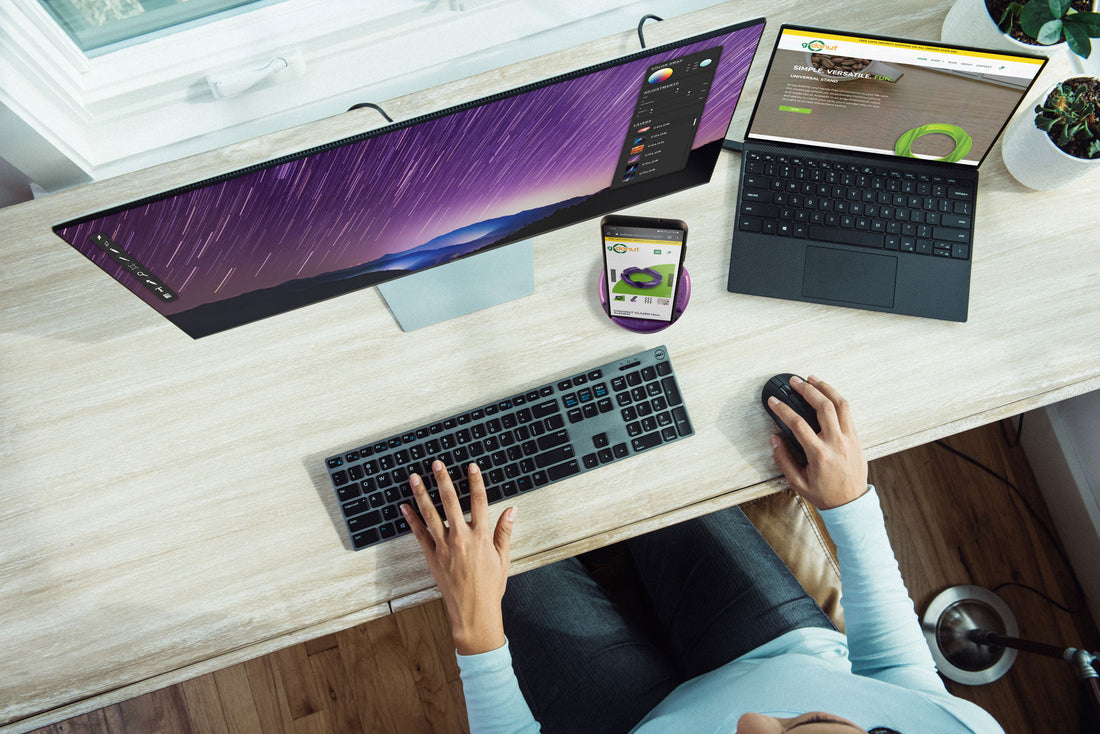
8 Ways to Not Ruin Your Back and Neck while Working at a Desk

Complaints of back and neck pain have been on the rise over the past year with more office workers doing their jobs remotely from home. Without the benefits of company-provided ergonomic chairs and desks, monitor and laptop stands, and reasons to frequently get up and walk to other parts of the building, remote workers have discovered the hard way that their home offices are ill-equipped for keeping them comfortable while sitting for eight or more hours a day.
Here are some ways to optimize your home office — or even your corporate office — so you can stop being distracted by pain.
1. Use a GoDonut mobile device stand
Most of us probably have our smartphone sitting on the desk next to us while we work so we can use it for job tasks and, of course, to communicate with friends and family during the work day. Leaning over your phone while it sits on a flat desktop is terrible for your neck, and propping it up against something securely enough to keep it from falling down is almost impossible. Use a GoDonut to hold your phone for you at one of three optimum angles. If you use your phone extensively, especially for video calls, set your GoDonut up on something closer to eye level to reduce neck strain.

2. Position your monitor
Your neck is happiest when your face is looking straight ahead. Working at a laptop doesn’t make that possible, though. Whether you use a laptop or desktop, set up a large, external monitor at eye level (set it on a monitor stand, a box, or books if you need to). And if you find yourself automatically leaning forward and craning your neck up, move your monitor closer to you. Your neck and back will thank you.
3. Adjust your chair to the optimum height
If your arms angle upwards to rest on your desktop while you type, your chair is too low. If they angle downwards, your chair is too high. Your forearms should rest comfortably at a 90-degree angle from your torso. Your thighs should also rest at a 90-degree angle. If you’re of short stature and you can’t get your office chair to adjust low enough, or if you have to set your chair to a tall height adjustment to fit with your tall desk, then use a footstool (boxes, books, and planks of wood work, too.)
4. Sit up straight
Your mother told you to, and she’s right, but it’s hard to do that if your chair back isn’t fairly straight. If your chair back is leaned way back, see if your office chair allows you to adjust the angle and lock it into position. Built-in lumbar support or a lumbar pillow (a rolled up towel works, too) can help relieve back strain as well.
5. Adjust your seat depth
Most people don’t think about how deep the seat on their office chair is, and most office chairs don’t allow you to adjust seat depth. If your seat isn’t deep enough, it can dig into the back of your thighs as they extend far beyond where the seat cushion ends. Or worse, if your seat is too deep, the edge of the cushion can dig into the back of your knees, giving you painful spots that will flare up when you walk.
6. Take microbreaks and gaze into the distance
Calling sitting worse than smoking may be an exaggeration, but it certainly doesn’t benefit your body to stay in one position for hours with only brief breaks to head to the kitchen or bathroom. Many companies still allow for smoke breaks. Use that time instead to stand up and move around. If you’re in an audio-only meeting, pace while you participate. Consider following the 20-20-20 rule: Every 20 minutes, focus on something at least 20 feet away for 20 seconds to reduce eye strain.
7. Do specific exercises and stretches to reduce your pain
The internet is full of videos and articles to help you address specific areas of back and neck pain with focused exercises and stretches. With over 2.6 million subscribers and hundreds and hundreds of videos, physical therapists Bob Schrupp and Brad Heineck have an incredible collection of helpful videos for strengthening your body and relieving pain.
8. Consider using a standing desk
The jury’s still out on whether or not standing desks have a long-term, significant benefit for office workers. What’s becoming apparent, though, is that most people who use them like to alternate between sitting and standing rather than staying on their feet for eight hours a day. Just remember: If you’re using a standing desk, make sure your monitor is still at eye-level and your arms are at a 90-degree angle.






